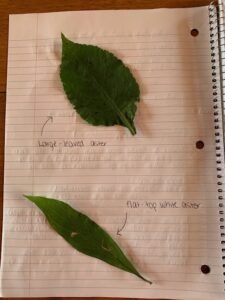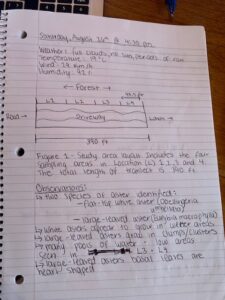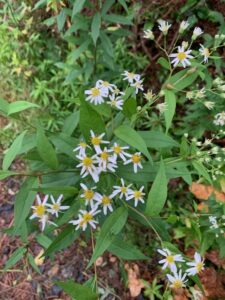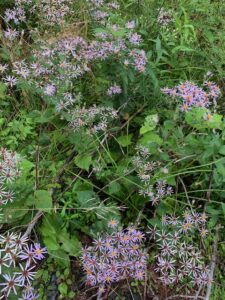- Study organism: flat-top white aster (Doellingeria umbellata) and the large-leaved aster (Eurybia macrophylla).
- Use your field journal to document observations of your organism or biological attribute along an environmental gradient. Choose at least three locations along the gradient and observe and record any changes in the distribution, abundance, or character of your object of study.
Location 1: area starts at road
Location 2: 97.5 ft from road
Location 3: 97.5 ft from location 2
Location 4: 97.5 ft from location 3
Total gradient length: 390 ft
I have observed that the large-leaved aster appears more abundant in L1 and L2 and the flat-top white aster more abundant in L3 and L4.
- Hypothesis: The flat-top white aster (Doellingeria umbellata) are the dominant species in shadier areas with wetter soil, and the large-leaved aster (Eurybia macrophylla), are dominant in sunnier areas with drier soil.
Prediction: In sampling areas 1 and 2, there should be more large-leaved asters due to the drier soil and higher frequency of clearings, leading to more sun exposure. In areas 3 and 4, there should be more flat-top white asters, where there is a denser tree canopy thus more shade, and wetter soil.
- Based on your hypothesis and prediction, list one potential response variable and one potential explanatory variable and whether they would be categorical or continuous. Use the experimental design tutorial to help you with this.
Response variable: presence or absence of the two different aster species at different locations along the gradient (categorical)
Explanatory variable: amount of sun exposure (categorical)




Excellent start to your hypothesis and predictions. I love that you saw that pattern in nature and want to explore it further.
A suggestion for your hypothesis would be to avoid using the word “dominant”. When I read it, it suggests to me that the one species pushes out the other which may not be the case and would require a competitive experiment to verify. Rather, you can say each species is preferential to its specified environment.
Your hypothesis and prediction characterize multiple factors which are clearly important for the preference of the plants to their environments (moisture, canopy and sun exposure), but your explanatory variable is just sun exposure. While the hypothesis can be a bit more broad, the prediction would read better if it was more specific and focused on just sun exposure.
On the other hand, if your goal is to characterize the preferred environments for the plants, you might need to track more explanatory variables like moisture measurements, soil types, and plant associations.
Good luck!